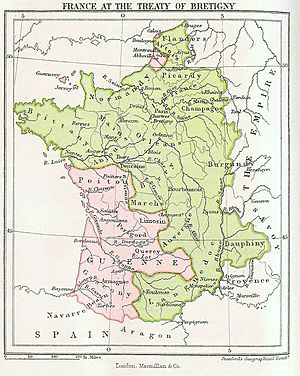Treaty of Brétigny facts for kids
The Treaty of Brétigny was an important agreement signed in 1360. It was made between King Edward III of England and King John II of France. This treaty helped end the first part of the Hundred Years' War. It also showed how strong England was in Europe at that time. The treaty was signed in a village called Brétigny, near Chartres. Later, it was officially approved as the Treaty of Calais.
Contents
Why the Treaty Was Needed
King John II of France was captured by the English. This happened at the Battle of Poitiers in 1356. While a prisoner, he worked with King Edward III of England. They tried to create an earlier agreement called the Treaty of London.
However, the French parliament, called the Estates-General, did not like this treaty. They told Prince Charles, who was ruling France while his father was captured, to refuse it.
King Edward III of England was not happy about this. He wanted to keep the advantages from the failed Treaty of London. So, he attacked the city of Rheims in France. The attack lasted a long time, and Edward's army ran low on supplies. He then moved his army to Burgundy. After another failed attack on Paris, Edward marched to Chartres. This is where talks for a new treaty began in April.
What the Treaty Said

The Treaty of Brétigny was first approved on May 10, 1360. Prince Charles of France and six English knights agreed to it. On June 14, 1360, King John II, who was still a prisoner in England, also approved it. This happened at a big dinner with King Edward III and other French prisoners. The final signing of the treaty happened in Calais on October 24, 1360.
Land Changes
Under this treaty, King Edward III gained a lot of land in France. He got Guyenne and Gascony, plus many other areas. These included Poitou, Saintonge, Aunis, Agenais, Périgord, and Limousin. He also received Quercy, Bigorre, Gauré, Angoumois, and Rouergue.
In northern France, England gained Montreuil-sur-Mer, Ponthieu, Calais, Sangatte, Ham, and Guînes. The English king would own these lands completely. He would not have to pay homage (show loyalty) to the French king for them. The treaty also said that the Channel Islands would no longer be under French rule. Edward changed his title from "Duke of Aquitaine" to "Lord of Aquitaine."
King Edward's Promises
In return, the King of England gave up his claim to the French throne. The treaty aimed to simplify the old feudal rules that caused so much fighting. England wanted to focus its power in a larger area of Aquitaine. England also gave back rights to the bishop of Coutances over Alderney. These rights had been taken away in 1228.
King John's Ransom
King John II had to pay a huge ransom to be set free. The amount was three million écus (a type of gold coin). He would be released after paying one million. This event led to the first minting of the franc, a new French coin.
To make sure the ransom was paid, King John gave hostages. These included two of his sons, Louis I of Anjou and John of Berry. Several other princes and nobles were also hostages. Four people from Paris and two citizens from each of France's nineteen main towns were also held.
Why the Treaty Failed
While the hostages were held, King John went back to France. He tried to raise money for his ransom. In 1362, John's son, Louis of Anjou, escaped from Calais. Since his stand-in hostage was gone, King John felt it was his duty to return to captivity in England.
King John died in England in 1364. His son, Charles V, became the new king of France. In 1369, King Charles V declared war on England again. He said that King Edward III had not followed the treaty's rules.
By the time the Black Prince died in 1376 and Edward III died in 1377, English forces had lost much land. They were pushed back to their territories around Bordeaux in the southwest.
What Happened Next
The treaty did not bring lasting peace. But it did give nine years of quiet during the Hundred Years' War. In the years that followed, French forces fought battles against other groups. These included the Anglo-Navarrese, where Bertrand du Guesclin won the Battle of Cocherel in 1364. They also fought against the Bretons.
See also
- List of treaties
- Treaty of Troyes


